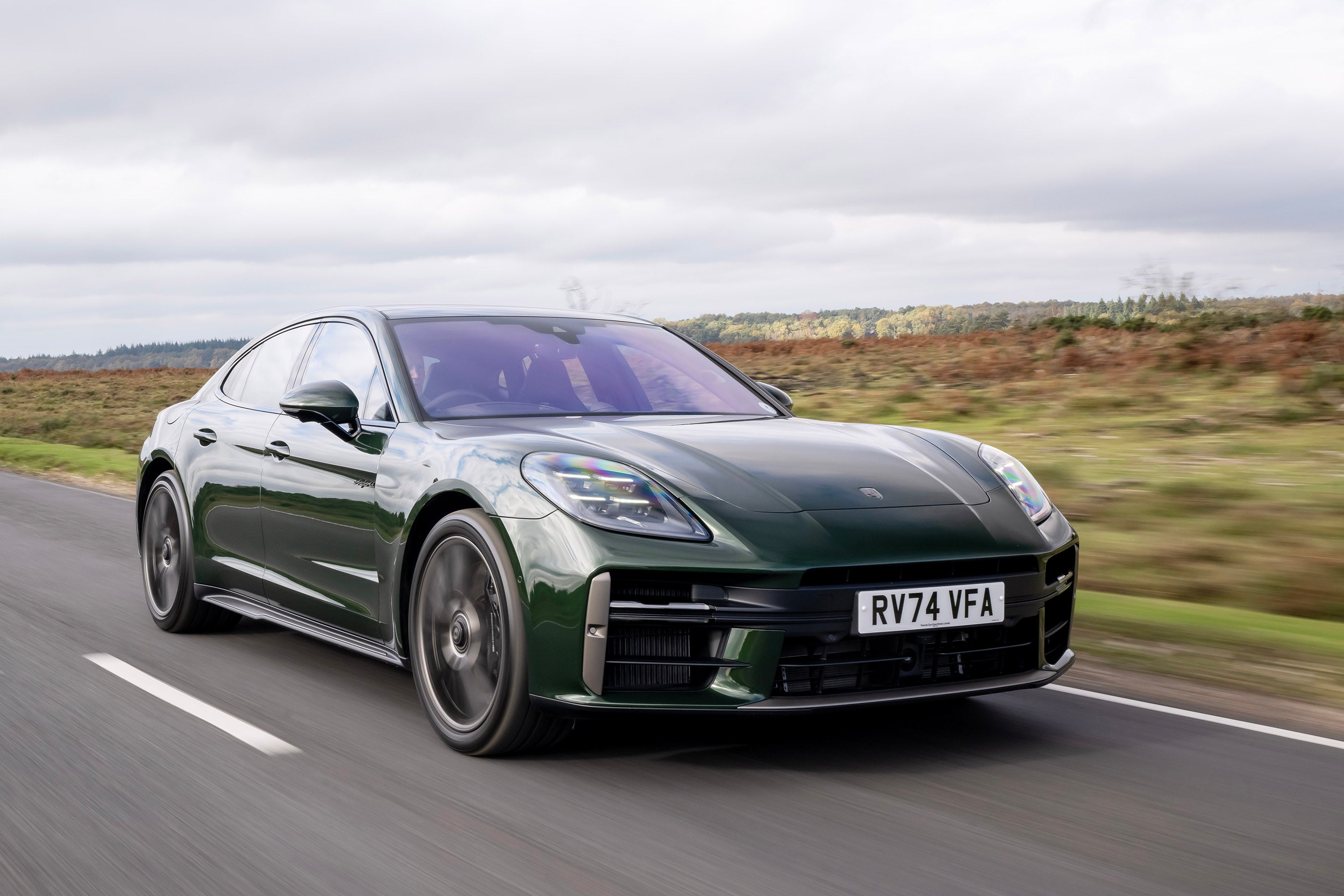Porsche Panamera Review 2025: Price, specs & boot space
Written by Matt Robinson
Quick overview
Pros
- Extremely capable and fun to drive
- Relaxing when you just want to cruise
- Plug-in hybrids offer useful electric-only range
Cons
- Not really 'all-new', even though a lot has changed
- No longer a Sport Turismo estate version
- Expensive, and that's before you start adding pricey options
Verdict: Is the Porsche Panamera a good car?
"The Panamera is newer than it might initially look, and is a seriously impressive luxury car that deftly blends comfort and a sporty drive. All things considered, it might well be the best car Porsche makes, but perhaps predictably, it's not cheap."
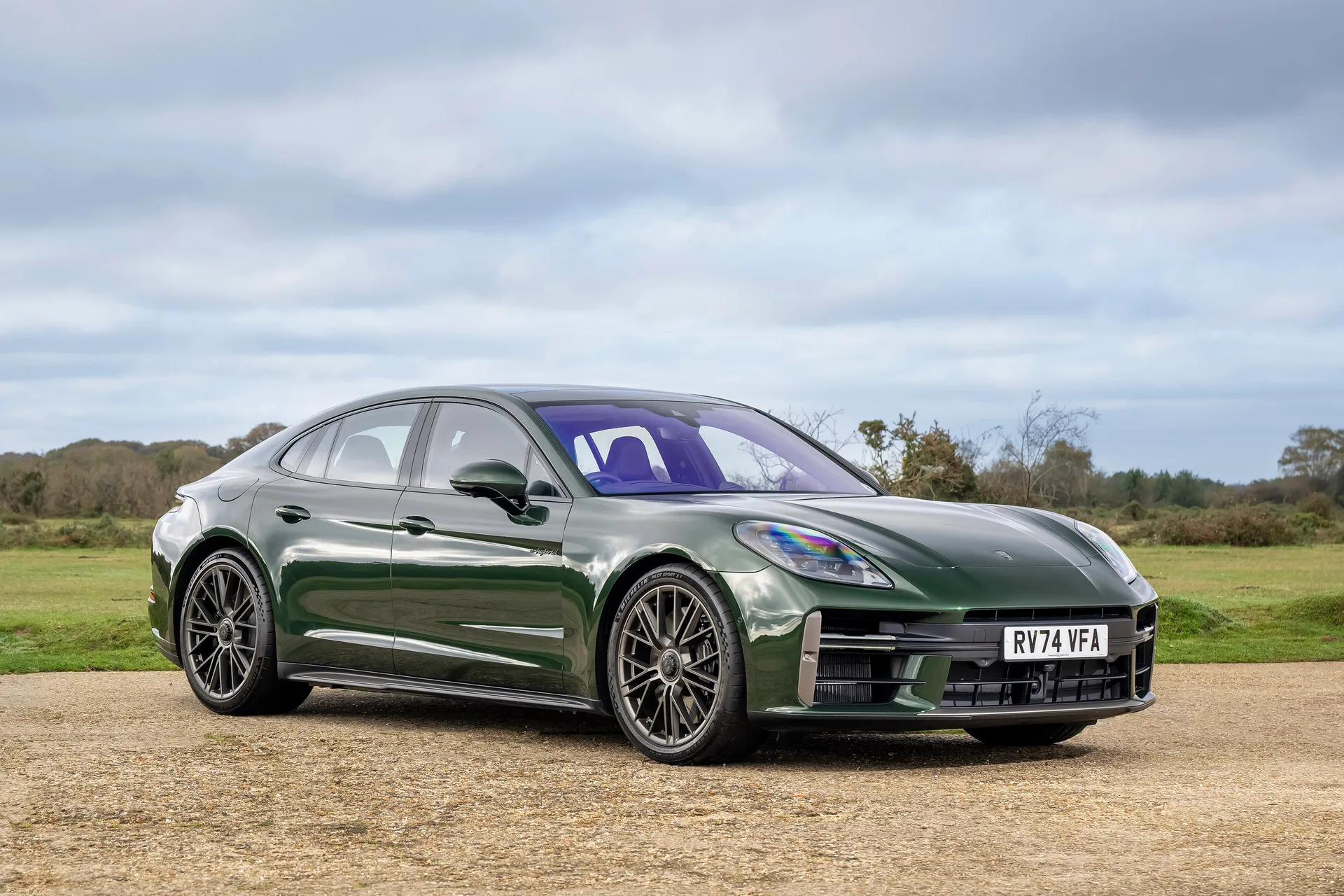
You might think that you're looking at a facelifted car, but as far as its manufacturer is concerned, this Porsche Panamera is an all-new car with a fresh chassis code. Proportionally, it's not all that different, and while the styling isn't what you'd call a radical departure, only the door skins are carried over from the outgoing second-generation model.
Plenty has been reused this time, but that's not necessarily a bad thing. What is a bad thing is the lack of Sport Turismo estate. Sadly, citing a lack of demand, Porsche decided to drop it for this new model. So, if you want to blame anyone, blame the buying public for not buying enough Panamera STs.
Anyway, we'll let that slide as there have been improvements across the board, including the presence of even more potent hybrid powertrains, incredibly clever technology including the new Porsche Active Ride system, and even - to our eyes at least - better looks.
No, it's not cheap, and Porsche is more than happy to offer a dizzying array of ways to extract even more money from you before taking the order. But the Panamera feels worth it given just how impressive it is to drive, and not just from when it comes to driving on a nice, twisty road. It rides brilliantly on its standard-fit air suspension, and refinement is first-rate.
The quicker versions are almost painfully fast off the line, but you shouldn't feel short-changed by the performance of any Panamera, as even the entry-level versions aren't sluggish.
Looking for a used car for sale? We've got 100s of Porsche Approved Used Cars for Sale for you to choose from.
Is the Porsche Panamera right for you?
If you want a luxury car but place its driving dynamics above all else, the Panamera is about as good as it gets. What's great about the current version is it does the whole luxury thing better than ever, so you aren't sacrificing all that much by ignoring other, less sporty options from other German premium manufacturers. You'll just need to have quite a bit of spare cash to both buy it and run it.
What’s the best Porsche Panamera model/engine to choose?
A lot of this will depend on how you intend to use the car. If your commute is within the electric-only range of the plug-in hybrid models, for instance, one of those could be worth a look. And then, you just need to decide how fast you want to go - is the V6 enough for you, or do you want the might of one of the electrified V8s?
The entry-level V6s will be enough for most, but keener drivers should look no further than the GTS. It has the V8 of the Turbo and Turbo S E-Hybrid models without the heavy battery and motor, making for a sharper-handling car. It's easily the best looking of the lot, too.
What other cars are similar to the Porsche Panamera?
This particular bit of the market is looking very different from when the previous-generation Porsche Panamera was launched. There currently isn't a Mercedes-AMG E63 for the car to do battle with, although if you're eying up the spicier end of the Panamera range, you might also want to give the Mercedes-AMG GT63 S 4 Door a look. It starts at £156,555, in similar territory to the Panamera Turbo and Turbo S.
At the time of writing, we were still waiting for an all-new Audi A7 to replace the recently discontinued model, and the Aston Martin Rapide hasn't been a thing for a while, but in any case, that was always a niche option. Speaking of which, the Maserati Quattroporte was a rival for the Panamera, but wasn't not a popular choice either, with only a handful sold in the UK every year before it was discontinued.
There is a rival from the same stable in the form of the Porsche Taycan. Yes, it's all electric, but the sizing of each Porsche model is reasonably comparable, and the Taycan range has an even broader spread of performance, with range-topping versions punting out over 1,000PS.
Comfort and design: Porsche Panamera interior
"The Panamera's cabin might not look significantly different from the old model's, but it remains a wonderful place to spend time, is loaded with tech and bears more than a passing resemblance to the interior of the 911 sports car."
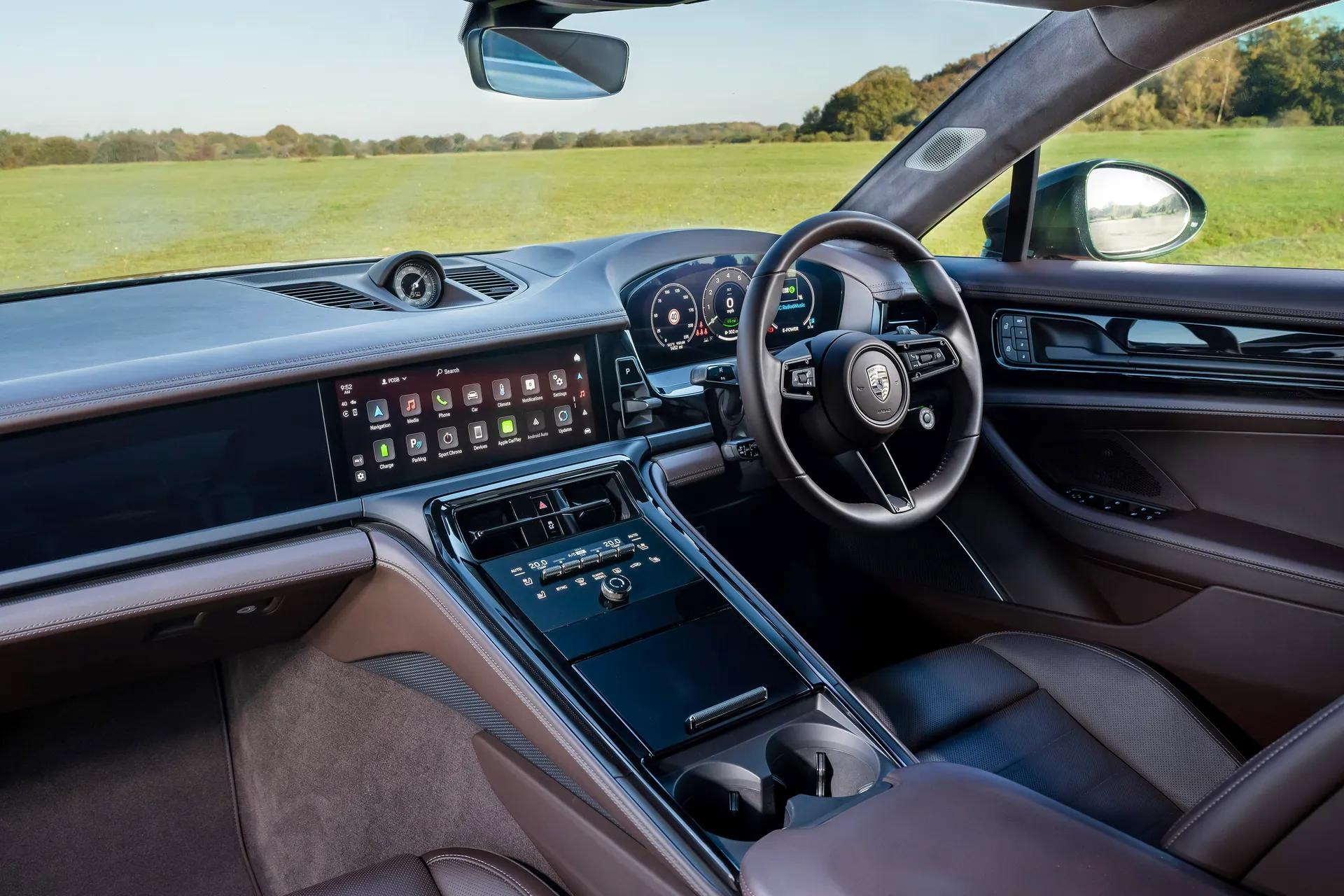
While the shape of the dashboard looks to be lifted straight from the old model, there's a whole new 12.6-inch digital instrument cluster, which - sadly - rids the car of the analogue cluster. It's a smart-looking unit, though, and appears to be similar, if not the same, as the one fitted to the Taycan.
It's a 12.3-inch touchscreen infotainment system, below which is a small digital display housed in a chunky centre console showing various climate information, but don't panic, because it's surrounded by physical controls for things like changing the temperature or fan speed. Further across, you can spec a 10.9-inch display for the front-seat passenger, which includes video streaming compatibility.
It's a subtly designed space on the whole that doesn't have a whole lot of wow-factor to it, but not everyone's after that. It can look great depending on the spec, as well, with our test car featuring gorgeous 'Espresso' brown upholstery. It's yours for £1,751.
Quality and finish
For the most part, the cabin is brilliantly finished, with an abundance of soft-touch surfaces, intricate stitching and wonderful details dotted around. We say 'for the most part', because Porsche is one of many manufacturers which loves to clad a lot of surfaces in a cabin with 'piano black' plastic.
Sure, it looks classy and plush when fresh, but we find these materials have a habit of picking up and 'proudly' displaying scratches. The stuff Porsche uses isn't immune - we tested a Taycan with around 11,000 miles on the clock just before the Panamera and a lot of its black trim was looking a bit second-hand already.
It's a small complaint, though. Otherwise, we reckon everything in the Panamera's cabin will wear the miles well.
Infotainment: Touchscreen, USB, nav and stereo in the Porsche Panamera
The infotainment screen is no bigger than before, measuring 12.3 inches across. That's on the smaller size by modern standards, with some rivals fitting ever-larger screens (just look at some of the screen-fests seen inside various new Mercedes-Benz models).
It isn't angled towards the driver, either, and some of the icons are on the small side. It's generally an easy unit to use, though, and the graphics look sufficiently crisp. Plus, unlike Panamera models of old, there's Android Auto in the model, because Porsche finally started offering this a few years ago, having previously only had Apple CarPlay in its vehicles. Both now come as standard.
We don't know what the standard audio system is like, as our test car had an optional Burmester 3D sound system, which was excellent, as it probably should be for something that costs either £4,601 or £5,822 depending on the Panamera model. If that's a bit extravagant for you, some derivatives have a Bose sound system fitted as standard, which is available optionally on lower grades for £1,223.
In terms of USB ports, you get two type-C sockets in the front and a further pair of type-Cs in the boot.
Space and practicality: Porsche Panamera boot space
The official boot capacity figure for the base Panamera models are broadly similar to that of the old model at 494 litres, or 1,328 litres with the rear seats folded. Meanwhile, the GTS manages 478 litres, or 1,321 litres with the rear bench folded.
As before, the plug-in hybrid models feature less boot space, owing to the packaging constraints of its big battery, but the drop isn't as big this time. The 4 E-Hybrid and 4S E-Hybrid each have 430 litres of space (expanding to 1,255 litres), while the Turbo E-Hybrid and Turbo S-E Hybrid models can take up to 421 litres (up to 1,264 litres) of clobber.
Previously, speccing the rear electric seats meant it wasn't possible to fold them, but that's no longer the case, with the 40/20/40 split-folding arrangement retained. The Panamera has a practicality edge over its saloon-based rivals with a hatchback-style boot opening, but there's quite a tall lip to load items over, and the load space itself is fairly narrow.
It's worth noting that the Panamera is a four-seater as standard. If you want it specced with five seats, or as a '4+1' as Porsche puts it, you'll have to tick an option in the configurator. However many people you're loading in they'll have an easier job of it if the Active Ride system is fitted, as it dramatically raises the suspension to make ingress and egress a breeze.
Handling and ride quality: What is the Porsche Panamera like to drive?
"The Panamera is the sportiest car to drive in the luxury car segment, but it's also better than ever at wafting you and your passengers around in absolute comfort when you're in a more sedate mood."
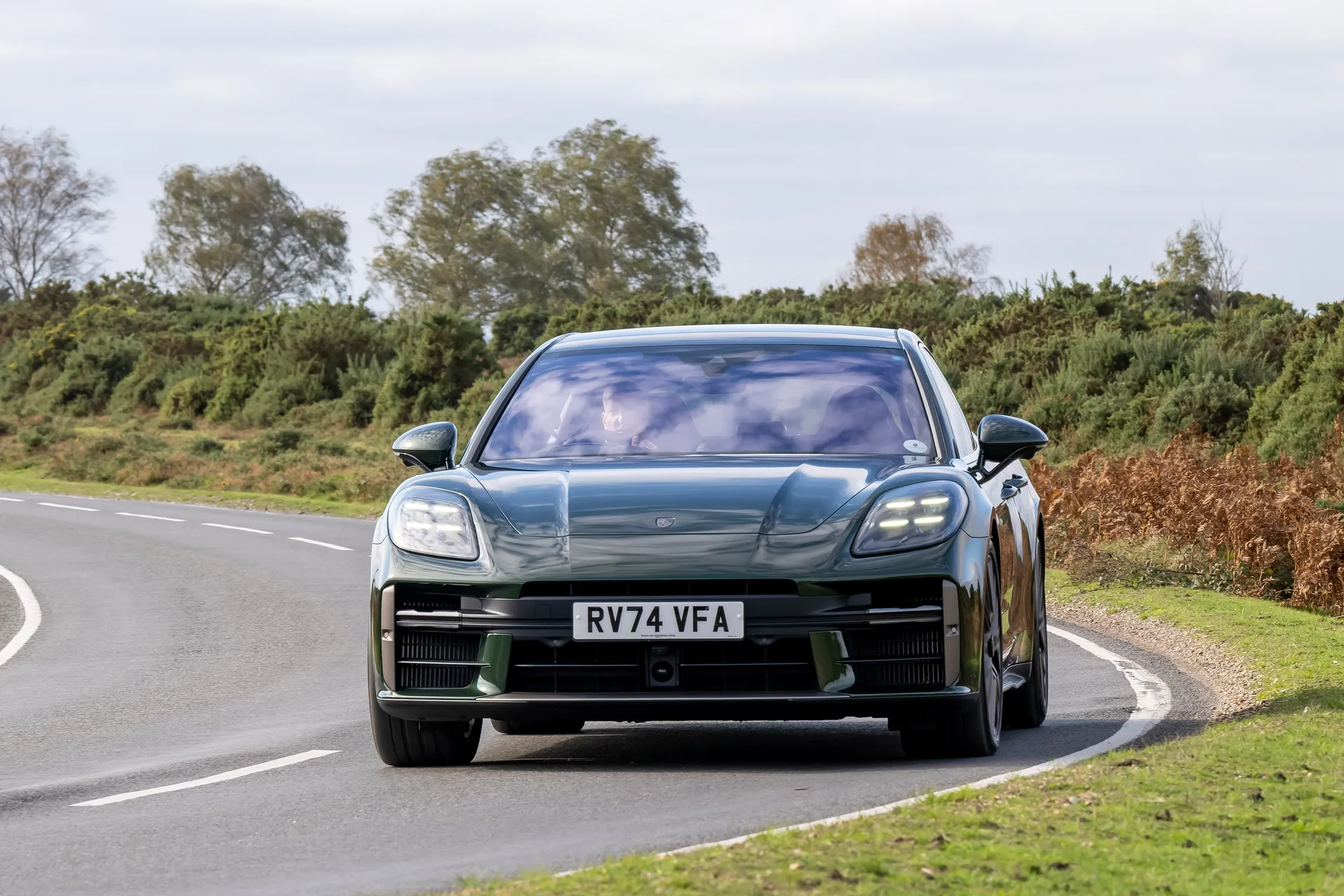
A big part of this duality is the new Porsche Active Ride system. It makes the car ride exceptionally well whatever the state of the road surface below, with only the occasional thump coming through to the cabin if any of the car's large wheels find their way into a particularly big pothole.
One of the Active Ride system's functions is to tip the car into a corner, like a motorbike, while also squatting the car down at the front when you're accelerating or the rear when you're braking. This means the Panamera can "overcompensate for pitching and rolling tendencies to reduce the acceleration forces acting on the occupants," as Porsche puts it.
The result of this is in some ways a little spooky, with very little inertia felt even when the car is cornering quite quickly, accelerating hard or braking significantly. The setup is extremely impressive and has an additional feature of quickly raising the car up significantly on one side as you get in, so it's not quite as much of a drop to slide your bum onto the seat. It's all very impressive, but it ought to be when it's a near-£7,000 option on all but the range-topping Turbo S E-Hybrid which gets it as standard.
The leaning/pitching thing is actually a bit counter-productive for more dynamic driving, so the function is switched off in the car's sportier modes, which instead see the air suspension drop the car closer to the ground while firming up significantly. This inevitably makes the car less comfortable, but without being excessively harsh.
It's remarkable just how quickly the Panamera can change direction. It simply doesn't feel like a car weighing the best part of 2.5 tonnes, although the rear-axle steering (another optional extra) will be helping make the car feel more agile.
Grip at the front end is amazing, as there's plenty of traction from the all-wheel drive system even when it has 680PS and 930Nm of torque being thrown its way. And on that front, it should come as no surprise that the Turbo feels exceptionally fast and responsive too, with the hybrid system making up for turbo lag.
It sounds great, too, even though we suspect the noise of the V8 is being supplemented a little bit through the speakers. Given how well-insulated the Panamera is, you can understand why Porsche has done this.
What engines and gearboxes/batteries and motors are available in the Porsche Panamera?
The range kicks off with a duo of 2.9-litre twin-turbo V6-powered models. The Panamera and Panamera 4 each has an output of 353PS, but owing to its traction-happy all-wheel drive system, the 4 is quicker from 0-62mph, dispatching the benchmark sprint in five seconds flat, compared to 5.3 seconds in the base Panamera.
The Panamera 4 E-Hybrid and 4 S E-Hybrid pair that same V6 with a plug-in hybrid system featuring an electric motor and a whopping battery pack with a useable capacity of 21.8kWh. That's comparable in size to the battery fitted to some early versions of the Nissan Leaf, and so the electric-only range of these models is very impressive.
There's an electric-only range of up to 57 miles in the 4, and 56 miles in the 4 S. In terms of performance, you're looking at a combined 470PS from the 4 E-Hybrid, making a 0-62mph time of 4.1 seconds possible, or 544PS and a 0-62 time of 3.7 seconds if you've opted for the 4 S.
For 'purer' performance thrills, the GTS uses a 4.0-litre twin-turbo V8 pushing out 500PS. So, it's less powerful than the 4S E-Hybrid, but with no battery to lug around, it's barely any slower, hitting 0-62mph in 3.8 seconds.
That same V8 appears in the Turbo E-Hybrid and Turbo S E-Hybrid, but combined with an electric motor. The Turbo generates a combined 680PS and can rocket from 0-62mph in 3.2 seconds. We can confirm that when using the launch control system, achieving this is actually a bit painful, so we can only imagine the fury of the Turbo S off the line.
It has a pokier motor for a total of 782PS and a monstrous 1,000Nm of torque. Its 0-62mph time is just 2.9 seconds, and it's also the only Panamera to top 200mph, with an official top speed of 202mph.
Porsche Panamera PHEV range: How far can you travel on a charge?
If you want a plug-in hybrid model, you're spoilt for choice since much of the range is made up of PHEVs. Thanks to the use of a very large battery, all of the PHEVs can go quite far on electricity alone, although the faster the model you choose, the lower the range figure will be. The 4 E-Hybrid manages up to 57 miles, trimmed to 55 miles in the 4S E-Hybrid. The Turbo E-Hybrid manages 52 miles, and finally, the Turbo S E-Hybrid is good for 50 miles.
It's notoriously difficult to replicate factory electric range figures like these in real-world driving scenarios, but 30 or so miles is an achievable target in all of them, we reckon.
Refinement and noise levels
As mentioned earlier when we were talking about the augmented engine sound, the Panamera is a car that leaves you well cocooned from any noises terminating from outside the cabin. Engine noise is barely there at a cruise, and it's the same case for wind noise, and the roar of the tyres is fairly well suppressed considering the sheer size of each contact patch. It's worth noting, though, that our test car has acoustically shielded glass fitted, which is a £1,170 option.
Safety equipment: How safe is the Porsche Panamera?
As was the case for the previous-generation Panamera, the new model hasn't been assessed by Euro NCAP. This shouldn't really worry you - of the Porsche models that the safety body has tested in the last few years, all have achieved the full five-star rating.
Standard safety equipment across all models includes traffic sign recognition, lane-keeping assistance, autonomous emergency braking, which can send a warning 'jolt' to the driver through the brake pedal before activating, a driver awareness monitor and a wide range of airbags.
It's a bit disappointing to see that a 'lane change assist' package including blind spot monitoring and rear cross traffic alert is a £740 optional extra even on the top-of-the-range model, however. These days it's typical for a car costing a fraction of what Porsche charges for the Taycan coming with similar technology as standard.
MPG and fuel costs: What does a Porsche Panamera cost to run?
"Fuel economy figures from within the Panamera line-up vary wildly, starting from 23.5mpg to 282mpg. The latter figure is for one of the plug-in hybrids, though, and you'll struggle to get that figure in real-world driving."
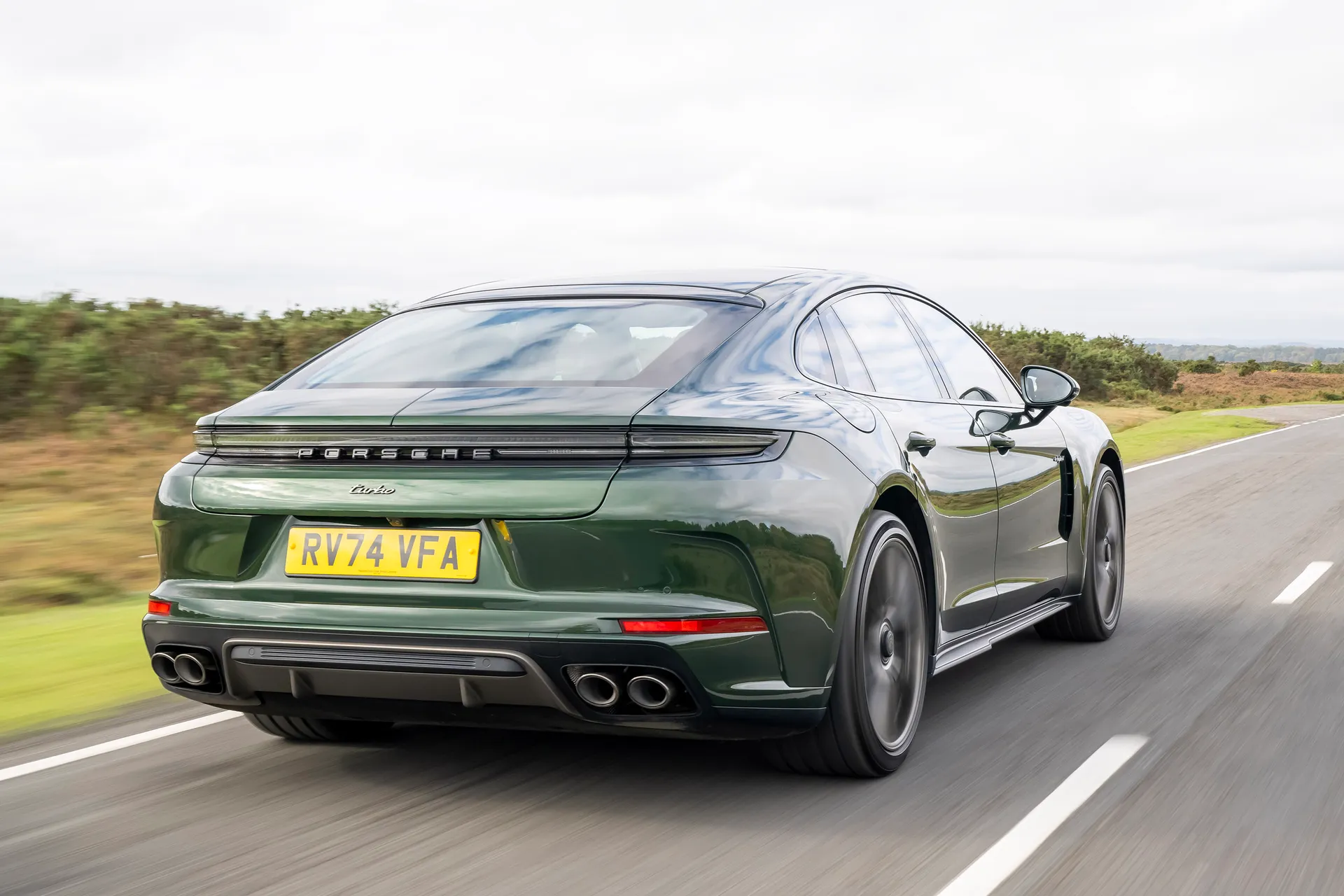
That's because lab-based emissions tests favour plug-in hybrids nicely due to them spending much of the assessment on electric power. This means the E-Hybrid is rated at 282mpg, the 4S E-Hybrid 256.8mpg, the Turbo E-Hybrid 235.4mpg, and the Turbo S E-Hybrid 201.8mpg.
Of course, you could leave home with a full charge, and if it's a short enough journey, not use a drop of fuel at all. But highlighting just how much the actual figure will vary, in the Turbo E-Hybrid we tested, we were a little way short of 235.4mpg. In fact, we managed about 18mpg. But a lot of the route was on a particularly lovely piece of twisty road - in more sedate driving, you'll get much more.
Away from the hybrids, there are some much easier-to-acheive figures. These are 29.1mpg for the Panamera, 28mpg for the Panamera 4, and 23.5mpg for the Panamera GTS.
Porsche Panamera reliability and warranty
The Panamera is still a very new car, but we're confident it'll prove reliable. Judging by how well Porsche does as a brand in the Honest John Satisfaction Index survey, the owners of its cars are generally a happy bunch.
The warranty length of three years is fairly standard, but its unlimited mileage coverage is a little more unusual, and nice to see, even if we don't expect many Panameras to exceed the more typical 100,000-mile threshold within this space of time. The batteries in E-Hybrid models are covered by a separate warranty lasting eight years or 100,000 miles, whichever comes first.
Porsche Panamera insurance groups and costs
As an expensive, high-performance luxury car, it should come as no surprise that the Panamera's insurance groups are of the lofty variety. In fact, every model is in the top group of 50, although you can expect the lower-powered/lower value versions to cost a bit less to insure. For a car like this, it might be worth trying specialist insurers as well as more mainstream options to try and get your premiums down.
VED car tax: What is the annual road tax on a Porsche Panamera?
The E-Hybrid models are classed as alternative-fuel vehicles and thus are liable for a lower rate of car tax than all other versions of the Panamera. But before you get too excited, the saving is all of £10, with the E-Hybrids liable for a £185 annual charge compared to £195 for the others.
All versions are a long, long way beyond the £40,000 threshold for the government's premium car tax, meaning each will be hit by an additional £425 annual charge from years two to five of ownership. This is based on the vehicle's original purchase price and is transferred whenever there's a change of the registered keeper, so you can't get around it by buying used.
Porsche Panamera price
"The Panamera range starts from £82,500 and grows to more than double that at the thick end of the configurator. That's not the end of the story, either - as with all Porsche models, there are myriad ways to inflate the price further."
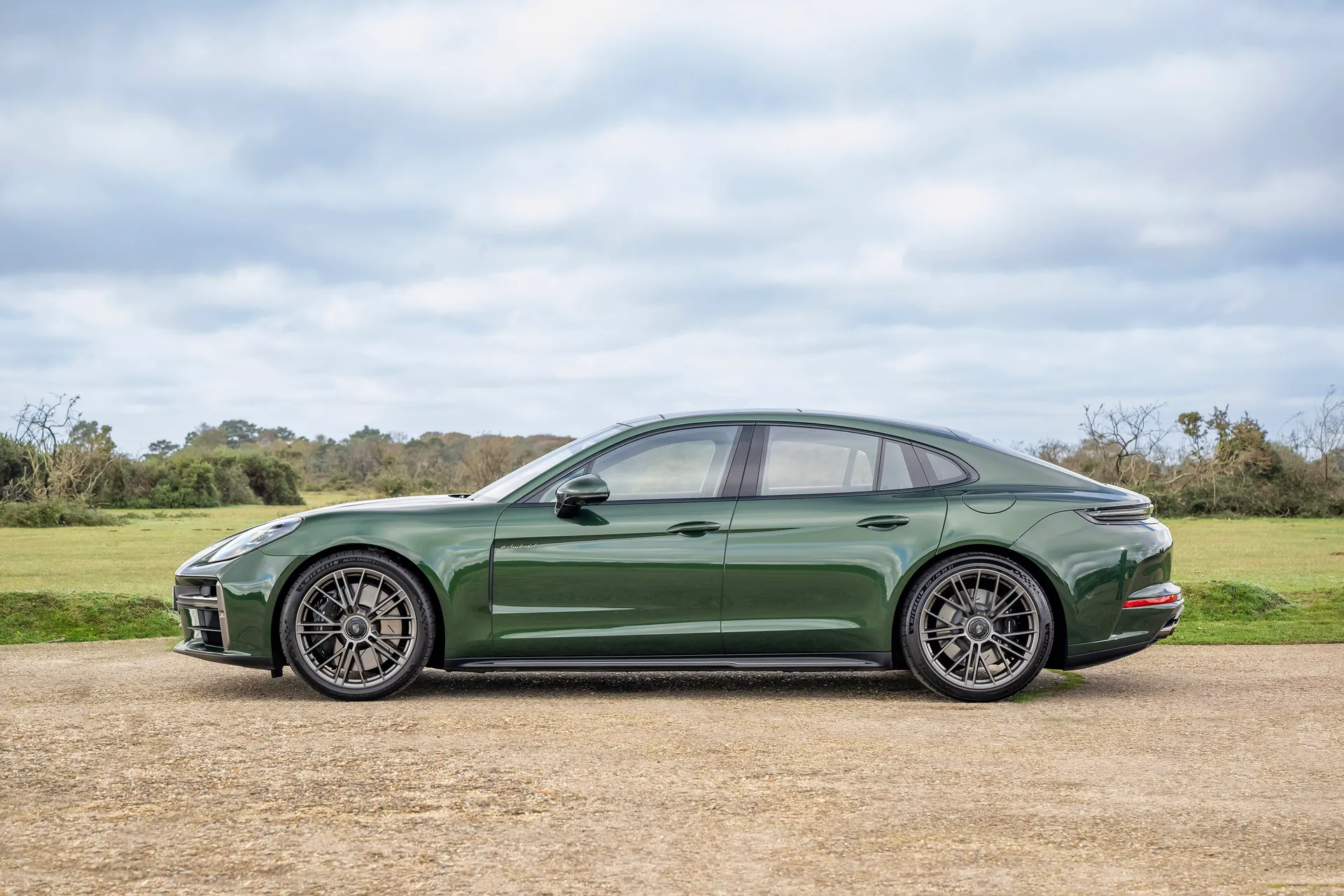
The starting point for the range is the simply called Panamera, and it costs £82,500. The Panamera 4 is £85,500, while the Panamera 4 and 4S E-Hybrid models are £91,000 and £102,100, respectively. It's a big jump from there to the Panamera GTS, which is £125,600, and two further sizeable bumps in price for the Turbo E-Hybrid at £145,400 and the Turbo S E-Hybrid at £168,700, the latter being more than double the price of the base model.
As you might have gathered from some of the optional extras already mentioned, there are plenty of items in the configurator that will increase these prices further. They range from frivolities like an £8,358 paint to sample exterior finish and an £11,265 carbon fibre 'aerokit', to things you might actually want like adaptive cruise control, which is £1,274, and neither does a 360-degree parking camera, which is £1,299 on top of the RRP. It's amusingly easy to put the price of a Turbo S E-Hybrid beyond £200,000.
It's early days for the third-gen Panamera used market, and while there are savings to be had, your choice will be limited. The previous-generation example is almost as impressive and can be bought for significantly less, with prices starting from around £30,000.
Trim levels and standard equipment
Each trim level of the Panemera is tied to a specific powertrain, which makes the range reasonably easy to understand. The specs between each aren't vastly different, with Porsche, for the most part, leaving it up to customers to pick from a vast array of options available on most models. Be warned, some of them are pretty pricey, so those base prices can quickly inflate by five-figure sums.
The Panamera 4 and Panamera 4 S each feature 19-inch alloy wheels, adaptive air suspension, matrix LED headlights, a powered tailgate and two-zone climate control. The Hybrid models build on this with the Sport Chrono package, which includes an analogue/digital stopwatch, a fruitier Sport Plus model and a track data recording function. The 4 S E-Hybrid also receives 20-inch alloy wheels.
The GTS features a raft of aesthetic upgrades, including 21-inch wheels shared with the Turbo S. Inside, there are 18-way electrically adjustable sports seats, a heated 'GT Sports' steering wheel and a Bose surround sound system.
The Turbo is broadly the same but misses out on the sporty aesthetic bits and uses a 20-inch set of alloy wheels. Finally, the Turbo S bumps the rims back up to 21s, and adds the fancy Porsche Active Ride system.
Ask the heycar experts: common questions
What does 'Panamera' mean?
How much does the Porsche Panamera cost?
Is the Porsche Panamera a good car?
Get our latest advice, news and offers
Keep me updated by email with the latest advice, news and offers from heycar.
By submitting you agree to our privacy policy
